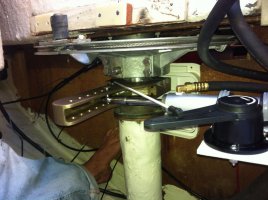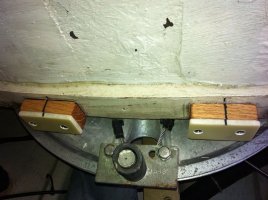Question, it is hard to tell from your photos, but is the arc for the rudder sensor going to work well even if the rudder sensor is moving with the fore aft vector of the arc of the hydraulic cylinder?
Good catch! This is something I considered during install and to be frank I don't know if it will be an issue or not. The ram only has about 7" of throw so there is minimal fore/aft arc, especially at the midpoint where the sensor is mounted. Also, the swing of the arc is more or less the same in both directions. But what finally sold me on trying this solution was that it is an extremely simple way to mount the sensor and that the Simrad computer "learns" to correlate the sensor position with the full swing of the rudder. While at the dock you tell it when the rudder is centered, full left, and full right. Then the computer moves the rudder through the full arc stop-to-stop and uses the information to calibrate the rudder position sensor. You probably already know this but maybe it's different for other makes? We plan to do initial sea trials this week and I'll post the results. If it's any problem it's easy enough to relocate the mount. In the meantime the display seems to indicate accurate information when I manually move the wheel.
By the way, I was shooting for 35-40 degree swing and we ended up with 40-43ish. Close enough and plenty of travel for maneuvering. It leaves a few mm buffer before max-travel on the ram on each side. Another easy thing to adjust if needed (my modifying the rudder stops).
Two, flip the pump around so that it is under the overhang... I know that it seems like you are going to need to add fluid to this thing, but once you get rid of the leaks and bleed it the first time, unless you take it apart you are never going to need to add fliud. Having it out of the way for getting whatever in and out of the locker will keep it from being damaged when people do get things in and out of the locker. Fill it when you must with a ketchup squeeze bottle with fluid in it, you don't need a lot of overhead clearance.
Your ketchup bottle idea is brilliant!!! Especially while underway when it would be more difficult to pour from a container. Thanks you!! To fill it while purging/bleeding we just stuck a funnel into a short piece of 1/2" hose. The other end had a threaded connector that screwed onto the cap of the reservoir. This allowed us to tilt the entire unit (pump, ram, etc) without spilling while filling to help get all the bubbles out.
As for flipping the pump around I had not considered that but it makes sense as long as it's still easy to add fluid if needed. For us it wasn't just about adding fluid but also about easily checking fluid level and inspecting for leaks. But flipping it would probably not make that prohibitively difficult. Since we don't use that space for storage and so far have had no difficulty easily getting in and out (relatively speaking) with the pump mounted where it is my first inclination is to leave it where it is but based on your feedback I'm gonna take a good look next time I'm down there. The biggest potential damage point as it stands now is the rudder position sensor. It protrudes further into the space than the pump and is much more difficult to see while lowering yourself into the space.
As first I thought you were trying to secure the ram with the clamps... Then I looked closer.. That was funny....


So you mean you're NOT supposed to clamp the ram in place??
Also your rudder sensor is maxed out on adjustment in one direction. That usually means that the arc isn't quite right. Be careful with that. I have seen a lot of people get into trouble that way.
I'm not sure what you mean by this but I'm very interested to know if I'm may be missing something here? In all the pics the rudder is centered. The sensor arm is positioned a mm or so off center. It still has play at both extremes of the swing. The sensor is rotated relative to the ram to allow for the "parallelogram" positioning relative to the center of the rudder post, ends of threaded rod, etc. The ram is positioned slightly aft of rudder post center so maybe that's why it looks like the sensor is maxed in the pic? The ram base is gimbaled and while the slightly aft position leads to slightly asymmetrical travel it does not max out in either direction. Your thoughts?
Thanks for taking the feedback Guy. I appreciate having an experienced eye looking things over!











